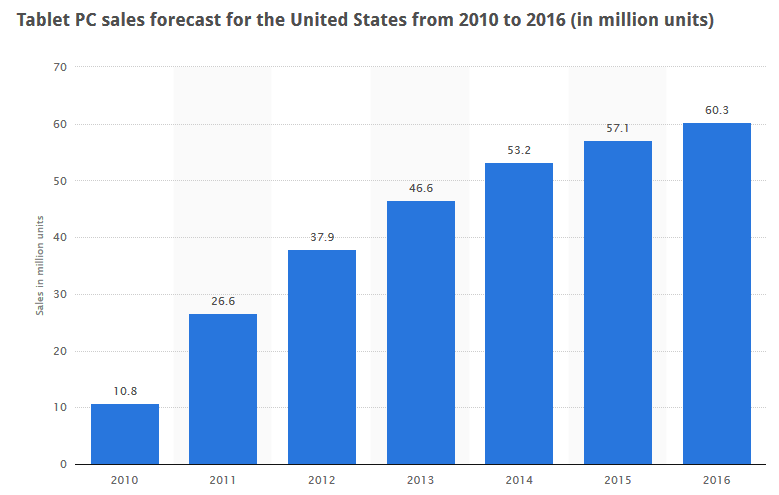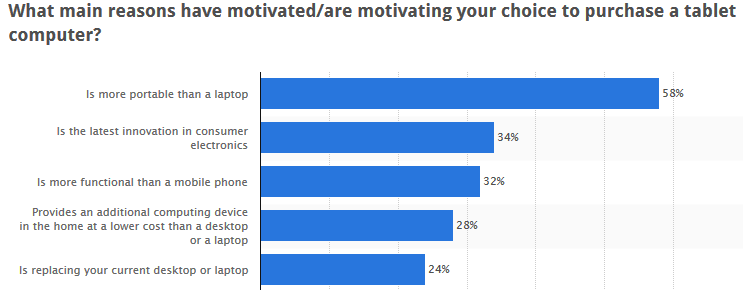The consumer market for tablets has virtually exploded in the last three to five years, growing exponentially from 10.8 million units sold in the U.S. in 2010 to 46.6 million tablets sold in 2013. While 2014 is only halfway through, experts are already speculating this current trend will result in a total of 53.2 million units sold by the year’s end.
 Source: Statistica.com
Source: Statistica.com
According to a worldwide survey performed in 2012 by Statistica.com, 58% of respondents ranked portability as the primary motivator for purchasing a tablet, and 32% of respondents stated another key reason for purchasing a tablet was that tablets are more functional than smartphones. Similarly, 24% purchased a tablet as a replacement for their desktop or laptop.

Source: Statistica.com
Demand for tablets is enabled by the proliferation of ubiquitous high-speed communication networks combined with the miniaturization of incredibly powerful processors, high-density memory, power management circuits, and innovative software, which allow the convergence of incredibly powerful technology onto a single device. Tablets are similar to their smartphone cousins from a tech standpoint, using much the same semiconductor and IC technology with the exception of having larger battery capacities, more powerful processors, and larger screens. In addition, tablets perform web browsing, word processing, 3D-rendering, limited 3D-modeling, communications, and video compression at the same level as the average laptop, but take up significantly less space. As a result, these devices serve as a middle ground between desktop, laptops, and smartphones, consolidating their functions into a single unit.
Maintaining a highly engaging user experience is contingent on delivering a device that is small and lightweight and does not compromise battery life in the process. The balance between portability and functionality is a direct result of component selection on the design side. Design engineers cannot be fixated on selecting the best-in-class power management circuit – instead, they must be vigilant in all aspects of design. The amplifier IC is a commonly overlooked technology, but is equally important to the design process. This technology provides an opportunity for saving space, extending battery life, and simplifying the design process, all while enhancing system performance.
Similarly, consumers’ growing demand for better electronics necessitates that design engineers comprehend the underlying characteristics associated with each audio amplifier topology in order to select the components most suited for maximum performance. Fundamentally, an audio amplifier magnifies the amplitude of a small signal to a useful level while simultaneously maintaining the signal’s signature, or linearity. The higher the amplifier linearity, the truer the representation the output signal is of its input.
Three of most commonly used amplifiers in portable media devices, like tablets and e-readers, are: Class AB amplifiers, Class D amplifiers, and Class G amplifiers.
Class AB amplifiers
Class AB amplifiers are a compromise between the high fidelity of Class A amplifiers and the lower power requirement of Class B amplifiers. They are an excellent choice for multimedia centered tablet headphone circuits requiring higher-than-average sound quality. The amps are able to produce this high quality sound at the lower power levels used in headphone applications.
Class AB amplifiers provide a high signal-to-noise ratio, which is the ratio of amplitude of the desired signal to the amplitude of noise signals at a given point in time (the higher the better). Maxim Integrated’s MAX97220 is an excellent choice for tablet headphone integration, as this highly reliable component offers low quiescent current while maintaining excellent SNR and low 0.003% THD+N.
Class D amplifiers
Tablet and smart phone speakers require much more powerful amplifiers for the loudspeaker circuit. The high efficiency of a class-D amplifier is the best choice for power conservation while maintaining a high quality sound. Class D amplifiers increase battery life through the use of pulse-width modulation to produce a rail-to-rail digital output signal with a variable duty cycle to approximate the analog input signal. Unlike Class AB amplifiers, the Class D variant exhibits an efficiency of 90% or more since transistors are either fully on or full off. Contemporary Class D amplifiers have even progressed to the point of providing Class AB amp fidelity. The primary drawback associated with Class D amps is their switching topology produces higher-than-average electromagnetic interference (EMI). Maxim Integrated’s MAX98304 mono 3.2W Class D amplifier features active emissions-limiting, edge-rate, and overshoot control circuitry which greatly reduces EMI.
Class G Amplifiers
Class G amplifiers resolve the issue of limited supply voltage that is commonly associated with portable audio applications, by using a charge pump to boost the supply voltage. In fact, Class G amps are similar to class AB amps but achieve a higher efficiency by the use of two or more supply voltages that are used only when the amplifiers’ output level requires. When the signal is low, the Class G amp selects a low supply voltage. As the output signal increases beyond the lower power level rail, the amp chooses a corresponding higher supply voltage to accommodate the needed increase.
Class G amps are more efficient than Class AB amps because they only use the maximum supply voltage when it’s required, whereas the Class AB amps use it at all times. Glass G amps are selected based on the appropriate speaker. Maxim Integrated’s MAX9730 speaker amp is optimized for traditional dynamic speakers, while the MAX9788 speaker amp is designed for ceramic speakers.
In conclusion
Be vigilant when selecting the best audio amplifier for your design because audio topologies continue to progress with the evolving needs of the audio and consumer technology market. Maximizing a tablet’s battery life and performance requires meticulous consideration of the details, beyond simply selecting the most appropriate power management IC. Considering the multimedia nature of the devices, audio amplifiers are equally important.
Advertisement
Learn more about Electronic Products Magazine





